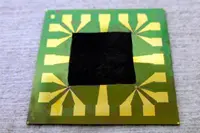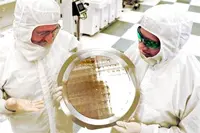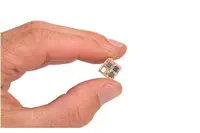Electronics News
Archive : 10 July 2015 год
 Researchers at MIT have unveiled a series of sensors, memory switches, and circuits that they hope to encode into common human gut bacterium. It is said these basic computing elements will allow the bacteria to sense, memorise, and respond to signals in the gut, with future applications that might include the early detection and treatment of inflammatory bowel disease or colon cancer.
Researchers at MIT have unveiled a series of sensors, memory switches, and circuits that they hope to encode into common human gut bacterium. It is said these basic computing elements will allow the bacteria to sense, memorise, and respond to signals in the gut, with future applications that might include the early detection and treatment of inflammatory bowel disease or colon cancer.
Researchers have previously built genetic circuits inside model organisms such as E. Coli. However, such strains are only found at low levels within the human gut, according to Timothy Lu, an associate professor of biological engineering, electrical engineering and computer science, who led the research alongside Christopher Voigt, a professor of biological engineering at MIT.
"We wanted to work with strains like Bacteroides thetaiotaomicron that are present in many people in abundant levels, and can stably colonise the gut for long periods of time," Lu said.
The team developed a series of genetic parts that can be used to precisely programme gene expression within the bacteria. "Using these parts, we built four sensors that can be encoded in the bacterium's DNA that respond to a signal to switch genes on and off inside B. thetaiotaomicron," Prof Voigt added.
To enable the bacteria to remember and report information externally, the researchers equipped B. thetaiotaomicron with used a class of proteins known as recombinases. These are claimed to record information into bacterial DNA by recognising specific DNA addresses and inverting their direction.
The researchers also implemented a technology known as CRISPR interference, which can be used to control which genes are turned on or off in the bacterium. The researchers used it to modulate the ability of B. thetaiotaomicron to consume a specific nutrient and to resist being killed by an antimicrobial molecule.
The researchers suggest that more advanced genetic computing circuits could be built upon this genetic toolkit in Bacteroides to enhance their performance as non-invasive diagnostics and therapeutics.
Author
Tom Austin-Morgan
Source: www.newelectronics.co.uk
 Black phosphorous is emerging as a serious challenger to graphene as researchers look for materials which might replace silicon in future electronic devices. However, chemists at the Technische Universität München (TUM) have developed a semiconducting material in which individual phosphorus atoms are replaced by arsenic. And, in a collaborative international effort, American colleagues have built the first FETs from the new material.
Black phosphorous is emerging as a serious challenger to graphene as researchers look for materials which might replace silicon in future electronic devices. However, chemists at the Technische Universität München (TUM) have developed a semiconducting material in which individual phosphorus atoms are replaced by arsenic. And, in a collaborative international effort, American colleagues have built the first FETs from the new material.
Black arsenic phosphorus forms extremely thin layers and is said to have potential applications ranging from transistors and sensors to mechanically flexible semiconductors.
New technology developed at TUM allows the synthesis of black arsenic phosphorus without high pressure, an approach requiring less energy and which is cheaper.
The advantage of black arsenic phosphorus is that it is a semiconductor. According to the team, the gap between valence and conduction bands can be controlled precisely by adjusting the arsenic concentration. "This allows us to produce materials with previously unattainable electronic and optical properties in an energy window that was hitherto inaccessible," said TUM Professor Tom Nilges.
With an arsenic concentration of 83%, the material exhibits an extremely small band gap of only 0.15eV, making it suitable for use in sensors which can detect long wavelength infrared radiation, including LiDAR, distance sensors in automobiles and the measurement of dust particles and trace gases.
Meanwhile, cooperation between TUM, the University of Regensburg, the University of Southern California and Yale has produced an FET made of black arsenic phosphorus.
Author
Graham Pitcher
Source: www.newelectronics.co.uk
 Researchers at Chalmers University of Technology in Sweden have developed a method which they say allows electronics devices to be cooled efficiently using a graphene-based film with a thermal conductivity capacity four times that of copper.
Researchers at Chalmers University of Technology in Sweden have developed a method which they say allows electronics devices to be cooled efficiently using a graphene-based film with a thermal conductivity capacity four times that of copper.
Professor Johan Liu's team showed a couple of years ago that graphene can have a cooling effect on silicon-based electronics. "But the methods that have been in place so far have presented the researchers with problems", he said. "It has become evident that those methods cannot be used to rid electronic devices off great amounts of heat, because they have consisted only of a few layers of thermal conductive atoms.
"When you try to add more layers of graphene, another problem arises, a problem with adhesiveness. After having increased the amount of layers, the graphene no longer will adhere to the surface, since the adhesion is held together only by weak van der Waals bonds."
"We have now solved this problem creating strong covalent bonds between the graphene film and the surface, which is an electronic component made of silicon."
The stronger bonds result from the addition of a property-altering molecule. Having tested several different additives, the Chalmers researchers concluded that adding (3-Aminopropyl) triethoxysilane (APTES) molecules had the most desired effect. When heated and put through hydrolysis, it created silane bonds between the graphene and the electronic component.
Moreover, functionalisation using silane coupling doubles the thermal conductivity of the graphene. The researchers have shown that the in-plane thermal conductivity of a 20µm thick graphene based film can reach a thermal conductivity value of 1600W/mK – four times that of copper.
"Increased thermal capacity could lead to several new applications for graphene," says Johan Liu. "One example is the integration of graphene-based films into microelectronic devices and systems, such as highly efficient LEDs, lasers and RF components for cooling purposes. Graphene-based film could also pave the way for faster, smaller, more energy efficient, sustainable high power electronics."
Author
Graham Pitcher
Source: www.newelectronics.co.uk
 IBM Research, in association with Globalfoundries and Samsung at SUNY Polytechnic Institute's Colleges of Nanoscale Science and Engineering (SUNY Poly CNSE), has produced the first 7nm test chips with functioning transistors. The achievement is a product of IBM's $3billion five-year investment in R&D, announced in 2014.
IBM Research, in association with Globalfoundries and Samsung at SUNY Polytechnic Institute's Colleges of Nanoscale Science and Engineering (SUNY Poly CNSE), has produced the first 7nm test chips with functioning transistors. The achievement is a product of IBM's $3billion five-year investment in R&D, announced in 2014.
With progress to smaller dimensions becoming increasingly difficult, the partners said they had to bypass conventional semiconductor manufacturing approaches to achieve their milestone. Included in the work are a number of 'industry firsts', including the use of silicon germanium (SiGe) channels and EUV lithography.
"For business and society to get the most out of tomorrow's computers and devices, scaling to 7nm and beyond is essential," said Arvind Krishna, director of IBM Research. "That's why IBM has remained committed to an aggressive basic research agenda that continually pushes the limits of semiconductor technology. Working with our partners, this milestone builds on decades of research that has set the pace for the microelectronics industry, and positions us to advance our leadership for years to come."
According to the partners, the 7nm chip achieves 'close to 50% area scaling improvements' compared to today's most advanced technology. This is expected to bring a power/performance improvement of at least 50% for next generation computing systems.
Author
Graham Pitcher
Source: www.newelectronics.co.uk
 Building on their previous collaborations, STMicroelectronics and the French Institute of Materials, Microelectronics and Nanosciences have announced the launch of a joint research laboratory to develop the next generations of high-reliability, ultra miniature electronic components.
Building on their previous collaborations, STMicroelectronics and the French Institute of Materials, Microelectronics and Nanosciences have announced the launch of a joint research laboratory to develop the next generations of high-reliability, ultra miniature electronic components.
Called the Radiation Effects and Electrical Reliability (REER) Joint Laboratory, the multisite establishment will bring together teams from the IM2NP Institute, based in Marseille and Toulon, and engineers from ST's Crolles site (pictured).
The REER Joint Laboratory's science program will focus on two main areas: the effect of radiation on nanoscale digital circuits; and the electrical reliability of nanoscale CMOS technologies.
According to the partners, the intrinsic constraints of electronic components and some environmental constraints – including particle radiation from natural or artificial sources – are becoming increasingly critical and therefore need to be characterised, modelled and simulated in order to predict and mitigate their effects.
The joint laboratory's research will range from the most fundamental aspects of phenomena at the atomic level to systems, materials, the physics of devices and the design of robust circuits.
The establishment is already involved in a number of collaborative programs and projects at the national, European and international level, including CATRENE, ENIAC initiative and support programmes led by the French General Directorate for Enterprises and the French defence procurement agency.
Author
Graham Pitcher
Source: www.newelectronics.co.uk
 Peratech has announced that its Quantum Tunnelling Composite (QTC) pressure-sensitive sensors have been incorporated into Flitchio, a smartphone case with built-in game controller. QTC is a screen printable polymer which changes its electrical resistance with applied force.
Peratech has announced that its Quantum Tunnelling Composite (QTC) pressure-sensitive sensors have been incorporated into Flitchio, a smartphone case with built-in game controller. QTC is a screen printable polymer which changes its electrical resistance with applied force.
Instead of having control interfaces on the screen that obscure the screen area used for gaming, Flitchio has two shoulder buttons and two ultrathin joysticks on the back surface of the case.
Dr. Amir Shadmand, ceo and co-founder of SUPENTA, makers of Flitchio, said: "Peratech enabled us to solve our challenges of making the joysticks sensitive, accurate and thin so that they fitted into a normal thickness smartphone case."
Flitchio snaps onto the phone and links by near field communication so that it can be used to play dozens of games, to pilot drones, to be a remote for Smart TVs, and to develop games and apps using a software development kit.
"QTC technology has been used to provide touch sensitivity for mobile phones before but this is the first time that someone has created a QTC-based product that uses the back of a device," Jon Stark, Peratech's ceo, said. "It's a perfect example of QTC technology enabling user experience innovations."
Author
Tom Austin-Morgan
Source: www.newelectronics.co.uk
 Avnet Abacus has signed a pan European distribution agreement with Taiwan-based MechaTronix, a developer of LED cooling solutions.
Avnet Abacus has signed a pan European distribution agreement with Taiwan-based MechaTronix, a developer of LED cooling solutions.
According to Abacus, thermal management is now a critical factor within LED fixtures and MechaTronix' range of LED coolers can provide passive or active heat dissipation for LEDs rated at up to 8000 lumen.
Alan Jermyn, vp marketing for Avnet Abacus, said: "This agreement means faster, easier access to these products for designers and manufacturers in Europe. It also fully complements the offering of our sister company, Silica and its team of lighting specialists, which can provide a complete lighting solution spanning LEDs, optics, drivers, connection and thermal management."
MechaTronix is said to be a 'preferred cooling partner' for LED manufacturers such as Cree, Lumileds, Osram and Sharp, providing thermal management products for a range of solid state lighting applications.
Pic: Don Schriek, left, product marketing manager, power, Avnet Abacus, and Koen Vangorp, general manager, MechaTronix
Author
Graham Pitcher
Source: www.newelectronics.co.uk
 Motion tracking technology specialist Xsens has released a series of self-contained 3D motion tracking modules for high volume industrial and 'prosumer' applications. The parts are said to be suitable for use in attitude and heading reference systems, vertical reference units and inertial measurement units
Motion tracking technology specialist Xsens has released a series of self-contained 3D motion tracking modules for high volume industrial and 'prosumer' applications. The parts are said to be suitable for use in attitude and heading reference systems, vertical reference units and inertial measurement units
The MTi 1-series is said to feature the latest in advanced sensor fusion and miniature MEMS technologies, but at low cost. MTi 1 devices are said to be individually calibrated and tested to enable minimal implementation effort. Each part offers a dynamic accuracy of 1° RMS for roll and pitch, which the company claims will make them the most accurate 3D motion trackers in their class.
Each MTi 1 module measures 12 x 12 x 2.5mm and can output orientation, acceleration, rate of turn and magnetic field data via its I2C, SPI or UART interfaces. The advanced and robust signal processing pipeline, along with the XKF3 sensor fusion algorithm, is said to ensure high performance in a range of applications. Onboard processing reduces the load on the application processor, cutting overall system power consumption.
Author
Graham Pitcher
Source: www.newelectronics.co.uk
 Silica has signed a distribution agreement with Nordic Semiconductor. The agreement authorises Silica to sell and support the full range of ultra low power wireless solutions available from Nordic across Europe.
Silica has signed a distribution agreement with Nordic Semiconductor. The agreement authorises Silica to sell and support the full range of ultra low power wireless solutions available from Nordic across Europe.
"We are excited to be partnering with Silica for our distribution across Europe. The technical and sales support they will offer our customers is vital as the connectivity market grows," said Morten Staale, Nordic's distribution sales manager for Europe. "Bluetooth low energy and wireless charging are focal areas for us. Silica has a proven track record in supporting customers in every stage of the design process, which, in this rapidly developing market, is crucial."
Mario Orlandi, president of Avnet Memec – Silica, said: "Silica, with its large engineering customer support team, is helping customers grow their business in a variety of electronics segments such as industrial, automotive and home automation. These segments are becoming increasingly connected and Bluetooth is a booming key technology for communications.Together with Nordic we can develop together new segments, going beyond the already successful consumer and wearable markets."
Pic: Mario Orlandi, president of Avnet Memec – Silica
Author
Tom Austin-Morgan
Source: www.newelectronics.co.uk
 Sales of semiconductors will reach $348billion in 2015, according to Gartner. While this represents a 2.2% increase over 2014, the market researcher has cut its previous forecast of 4% growth due to what it calls 'softness in key electronic segments'.
Sales of semiconductors will reach $348billion in 2015, according to Gartner. While this represents a 2.2% increase over 2014, the market researcher has cut its previous forecast of 4% growth due to what it calls 'softness in key electronic segments'.
"The outlook for the major applications that drive the semiconductor market, including PCs, smartphones and tablets, have all been revised downward," said Jon Erensen, research director. "This, combined with the impact of the strong dollar on demand in key markets, has resulted in a lower semiconductor forecast for 2015."
While demand for smartphones and solid state drives (SSDs) will drive semiconductor sales, the PC segment will see a decline in production of 8.7% in 2015. "Inventory in the PC market remains high, despite vendors looking to clear the supply chain in anticipation of Windows 10 and Intel's Skylake products," Erensen noted. "Any issues with the launches of Windows 10 or Skylake in the third quarter of 2015, which are expected to reinvigorate PC sales, could lead to further decline."
Despite the hype surrounding wearables, these devices will only represent 1% of demand, with smartwatches – such as the Apple Watch (pictured) –leading the sector.
"The typical second quarter bounce did not materialise this year," Erensen observed. "As a result, the semiconductor industry is more back end loaded and dependent on a strong third quarter rebound, driven by Windows 10 and the ramp up to the holiday season."
Author
Graham Pitcher
Source: www.newelectronics.co.uk

